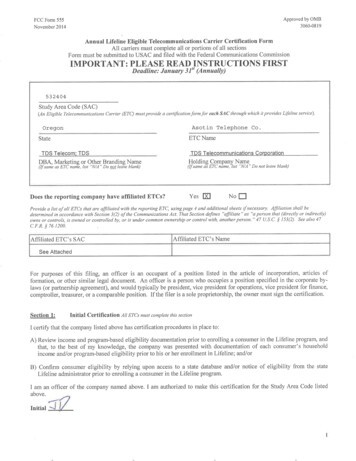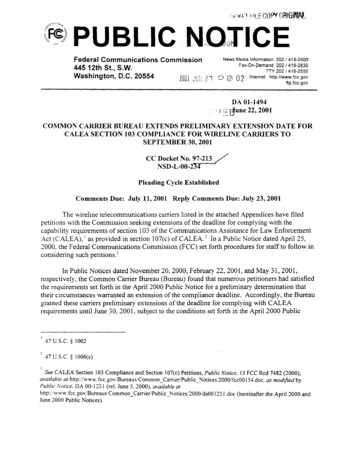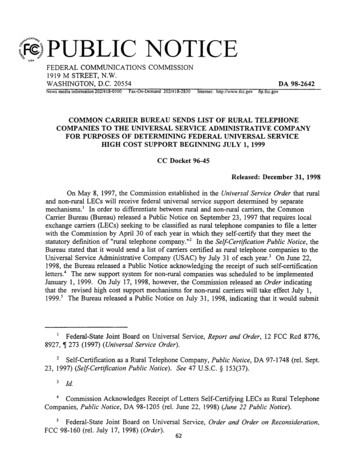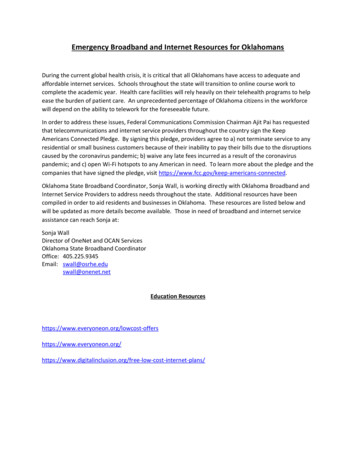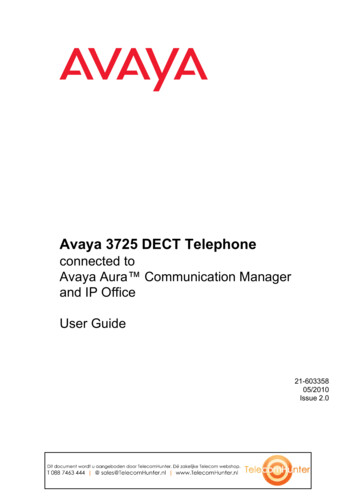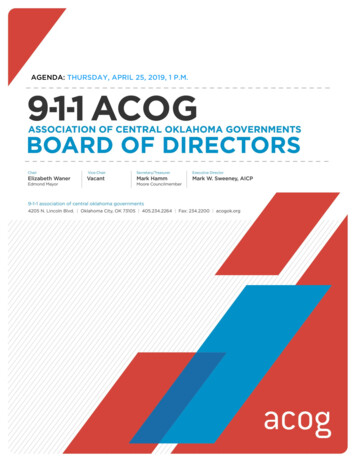
Transcription
An Evaluation of SamaritansTelephone and Email Emotional Support ServiceKristian Pollock, Sarah Armstrong, Catherine Coveney and John Moore.
An Evaluation of Samaritans Telephone andEmail Emotional Support Service2010Kristian Pollock, Senior Research Fellow1Sarah Armstrong, Associate Professor in MedicalStatistics2Catherine Coveney, Research Associate1John Moore, Research Fellow11Department of Nursing, Midwifery and Physiotherapy, Universityof Nottingham2The NIHR Research Design Service for the East MidlandsAddress for correspondence:Kristian PollockSchool of Nursing Midwifery and PhysiotherapyQueen’s Medical CentreUniversity of NottinghamNottingham, NG7 2HATel: 0115 8230810Email: kristian.pollock@nottingham.ac.uk2
AcknowledgementsFirst of all, we would like to acknowledge the contribution of Martin Anderson (MA) whoinstigated and led this project as Principal Investigator until serious illness forced him towithdraw in January 2009. Michelle Stubley (MLS) worked on the study as full timeResearch Associate between January 2008 and June 2009. Kristian Pollock (KP) andSarah Armstrong (SA) would like to acknowledge the input of John Moore (JM) andCatherine Coveney (CC) who joined the research team in September 2009 and havemade an invaluable contribution to the process of taking the project through tocompletion. We would like to thank Sarah Chaudhary for her input into the history andpolicy of Samaritans and Kevin Harvey and Paul Crawford for helpful discussions aboutthe analysis of the email data. We are very grateful to Julie Repper for taking on thetask of critical reviewer of the report. Her input has done much to improve the clarityand focus of the content. Many thanks also to Patrick Callaghan, Mark Avis andespecially Jacqueline Collier for their help and support throughout the project. We aregrateful to all the Samaritans who have contributed to this study, especially the casestudy branches for their openness in allowing us to observe their work, and for the manyhours spent in interesting discussions with the volunteers on shift. KP would like toacknowledge the input of her excellent SIT trainers in developing her insight andunderstanding of Samaritans principles and practice. Finally, we are grateful to thecallers who took part in interviews, granted permission for access to texts and emailsand responded to the online survey on a scale we had not anticipated. The result hasbeen the collection of a very substantial body of data about callers’ expectations andexperience of contacting Samaritans which we hope will extend the currentunderstanding of its work and point to the best ways of developing this in future.Cover photograph courtesy of John Moore to John Moore for cover image.3
Note on Transcribing Conventions for Data ExtractsAs interview transcripts are already representations of data, the extracts reproduced inthis report have been edited in places for clarity and conciseness. However, as ‘raw’data, the email messages and responses and callers’ written responses to the openquestions in the online questionnaire are reproduced exactly as they were written in theoriginal sources.PrefixesV (V202) volunteer interview respondentS (S110) caller interview respondentES (ES514) extract from caller email message. The number in parenthesis indicatesthe position of the message in the exchange (ES514 (2)).EV (EV514) extract from volunteer response to caller email message. The number inparenthesis indicates the position of the message in the exchange (EV514 (3)).EMFB an extract from email correspondence sent by callers directly to the researchteam in which they comment on, or give an assessment of, their experience of contactwith Samaritans (email feedback).ID (ID1125) an extract from a caller’s written response to open questions in the onlinesurvey.4
ContentsChapter One: IntroductionIntroductionResearch AimsBackground: The SamaritansOriginsSamaritan BefriendingStructure of the organisationVolunteer training and recruitmentNature of serviceSuicide preventionAccessing the serviceRestrictions on who may callConclusionReferencesChapter Two: Design and MethodIntroductionEthical approvalThe project website and promotion of the studyThe online surveyThe interviewsBranch observationsSIT trainingEmail and SMS text messagesData analysisSurvey dataQualitative dataReferencesChapter Three: The VolunteersIntroductionThe volunteersReasons for becoming a SamaritanSection summaryExpectations and prior knowledge of the SamaritansSection summaryTrainingAdditional benefits from trainingConsistencyElements missing from trainingSIT versus training pre-SIT (‘Prep’)Role plays (‘skills practice’)Branch relationships with General Office regarding trainingOngoing 2727282828293131313235353636383939404141425
Variance between branchesSection summaryThe experience of volunteeringBeing a SamaritanProblems encountered by volunteersExtra responsibilitiesVolunteers’ time commitmentAge and experienceSection summarySupport for volunteersBenefits of the volunteer support systemThe role of the duty leaderProblems and issues in accessing volunteer supportListening-in to calls as a method of supportSection summaryVolunteer turnoverSection summaryChapter 45555Chapter Four: The Online Survey: Callers’ perspectives onSamaritans emotional support services56IntroductionSamaritans data regarding annual callers and contactsThe online surveyDemographicsUse and experience of Samaritans’ services at the last time of contactMeans of contactSex of volunteerSpeed of responseRecency of last contactMain reason for contactFeelings before last contact with SamaritansFeelings after last contact with SamaritansComparison of feelings before and after last contact with SamaritansComparison of how respondents felt at the time of completing the onlinesurvey and how they felt after last contact with SamaritansReactions to being asked about suicide during last contactPositive feelingsNegative feelingsFeeling embarrassed or surprisedOther feelingsPrevious experiences of Samaritans’ servicesReasons for past contactSatisfaction with previous contactsExpectations and evaluation of serviceExpectations prior to contactExtent to which expectations were 0846
Better than expectedWorse than expectedNeither better nor worse than expectedExperience of serviceEmailsGood volunteers‘Moving on’Section summaryPerception of service and anticipation of future contactContact with other servicesVoluntary organisationsStatutory ServicesAlternative servicesSection summaryChapter 104Chapter 5: Callers’ perspectives in interviews and 7IntroductionDemographicsUse of the serviceMeans of contactFrequency of contactInformal support networksSection summaryAttitude to seeking helpReasons for callingExpectations of serviceEmail dataGood callsChapter SummaryReferencesChapter Six: Handling CallsIntroductionIndividual approaches to handling callsReflection and self-appraisalThe Good CallBeginning callsEngaging with the callerEstablishing empathyListening to callersFeelingsWhat to say and how to say itDefining and categorising inappropriate callsCallers with mental health 1291301317
Nature of serviceManipulative callersCaller CareDependencySelf disclosure and exchange relations in the contact between caller andvolunteerEnding callsChapter SummaryReferences134135137138139Chapter Seven: Giving Advice and Exploring Options145145145IntroductionSamaritans emotional support service: giving advice versus exploringoptionsAspects of advice-givingSection summaryAnalysisAnalysis of open survey questionsSection summaryAnalysis of caller and volunteer interview dataSection summaryAnalysis of email and text message dataQuestions embodying adviceUsing ‘hedges’ & ‘mitigations’Direct forwarding to other organisationsOther methodsSection summaryChapter SummaryReferencesChapter Eight: SuicideIntroductionAnalysis of volunteer interview dataThe frequency of suicidality in contactsAsking about suicide in contactsBeing suicidalHandling calls from people who are suicidalSuicide prevention and interventionSamaritans’ policy of self-determinationStaying with callers to the point of deathKnowing what happens to suicidal callersBeing affected by suicidal callersSection summaryAnalysis of callers’ interviews and emailsBeing asked about suicide in contactsReported reasons for acts of suicideBeing 91801801811828
Suicidal language, action, and intentCaller issues when actively suicidalSuicide and self-harmThe relationship between suicide and mental illnessRelationships with others while suicidalSection summaryChapter SummaryReferences184187188189190191191192Chapter Nine: Mental health IntroductionVolunteer perspectivesSamaritans services as filling a gap in mental health service provisionSamaritans services as complementary to statutory servicesEducation and training in mental health issuesCaller perspectives: survey dataCaller perspectives: interview dataSamaritans, other services and support networksSamaritans as a complementary form of supportSamaritans as filling a gap in service provisionSamaritans as the callers only source of supportSamaritans and other services as equally unhelpfulChapter SummaryReferencesChapter Ten: Improving the serviceIntroductionInteractional issuesCaller perspectivesBeginning the callBeing humanSilenceRepetitionAsking about suicidal feelingsScripted responsesSharing opinions and giving adviceEnding the callVolunteer perspectivesSection summaryPractical IssuesAccess and availabilityLength and speed of contactNew technologiesChoice of volunteerLinks with other servicesSection summaryRecruitment and training of 212212212242252252272282289
Caller perspectivesVolunteer perspectivesSection summaryThe wider promotion of Samaritans servicesSection summaryChapter SummaryReferences228230231232233233234Chapter 11: 43243244244245246IntroductionThe views and experiences of Samaritans volunteers in delivering servicesRecruitment and trainingOrganisational and peer supportGood calls and inappropriate callsCaller careAdviceMental Health IssuesSupply and demandThe needs and expectations callers have of contacting SamaritansInitial expectationsCallers’ in-depth experiences of contacting SamaritansNegative experiencesImprovements to serviceMental health issuesSuicideMeeting and defining needsThe nature of support offered by Samaritans services and the current callercentred approach taken in relation to best practice across the serviceSupporting the suicidalSuicide and mental illnessSelf determinationCategorising callersContrasting agendasOutreach and ReferralEntitlement and restrictionLimitationsConclusionReferencesChapter 12: Summary and ConclusionIntroductionAims and objectives of the researchDesign and methodData collectionAnalysisThe views and experiences of Samaritans volunteers in delivering servicesInvestigating the needs and expectations of 5625725725910
Handling callsGiving advice versus exploring optionsSuicideMental Health issuesImproving the Reasons for exclusionAwareness of SamaritansEthnic origin of survey respondentsReasons for choosing method of contactDetails of respondents’ experience when they last contacted SamaritansRespondent’s feelings at the end of last contact with SamaritansImpact of contact with Samaritans on respondent’s feelingsComparing main reason for last contact with caller’s reaction to being askedwhether they were feeling suicidal9: Details of services used in previous contacts10: General satisfaction with previous contacts with Samaritans11: Consistency and helpfulness of service12: Expectations of service prior to contacting Samaritans13: Experience of previous contact with Samaritans14: Suggested ways in which Samaritans could improve their service15: Anticipation of future contact16: Other services respondents were in touch with when they last :3:4:5:6:7:8:Age group of survey respondentsLiving arrangementsMethod of last contactComparison of method of last contact by age group of respondentsMain reason for contacting SamaritansFeelings before last contactReasons for past contactComparing main reason for last contact between those who have onlycontacted once and those that have used the service more than once585961616566777811
AppendixI. Samaritans Principles and PracticesII. Samaritans ‘Nature of Service’ PoliciesIII. Samaritans Vision, Mission and ValuesIV. The Online Survey QuestionnaireV. Caller Contact SheetVI. Survey Data: Additional Tables26826827027327429129212
Chapter One: IntroductionIntroductionThis report presents the key findings from an independent two year evaluation ofSamaritans telephone and email support services carried out by researchers fromNottingham University. For more than fifty years Samaritans have been providing roundthe clock confidential emotional support for people who are experiencing feelings ofdistress or despair, including those which may lead to suicide1. Samaritans also work toreduce the frequency with which people take their own lives by promoting a better publicunderstanding of suicide and suicidal behaviour and an acceptance of the value ofexpressing feelings which may otherwise result in suicidal action2. The hallmark ofSamaritans support is respect for the autonomy of the individual and their right toindependent decision making, extending even to the decision to end their life. Anothertenet is the value of non-judgemental and supportive listening in enabling individualsthemselves to work through their problems or at least develop viable coping strategiesfor managing difficulties. A singular feature of Samaritans is a focus on suicide andacceptance of the need callers may have to explore their suicidal feelings and intentionswithin the security of an anonymous, confidential and non-judgemental setting. However,the organisation has made itself available to anyone experiencing emotional difficulty ordistress and in the past has taken a notably inclusive attitude in allowing callers to definetheir own need and determine their own use of the service. While Samaritans will notactively dissuade callers from taking their own lives, a primary goal is that the emotionalsupport volunteers provide will deter people from resorting to suicidal actions. Thus thecore principle of self determination co-exists with a primary organisational goal tocontribute to a reduction in suicide.In 2008 Samaritans recorded a total of 5,159,698 contacts, by phone, email, text, letter,minicom, face-to-face at a branch, and at local and national festivals and other eventsand settings outside branches. Nearly 15,000 active volunteers responded to 2,715,226overt (dialogue) calls for support. An additional 2,444,472 (47.4%) phone contacts were‘snap’ or silent calls in which no dialogue could be established [1]. In recent yearsSamaritans has expanded the means by which callers can make contact, including emailand SMS messaging. The email service began in 1994 and had been implemented in themajority of branches (193) by the end of 2008 by which time it accounted for 6.7% ofdialogue contact (160,351 messages sent). SMS Text messaging was initiated in 2006and operated by 32 branches by the end of 2008, accounting for 3.9% of total contacts.Callers have responded positively to these new services, with their use increasing rapidlyin the few years since their initiation. However, most contacts (88.5%) are still made byphone. The majority of contacts with Samaritans are judged to be from people indistress rather than intense despair. Callers were assessed by volunteers to expresssuicidal thoughts and feelings in a fifth of dialogue calls although only a very smallnumber of callers were judged to be actively suicidal at the time of the call. Suicidalfeelings were expressed more commonly (36%) in emails. Twenty per cent of calls werereported to involve inappropriate use of the service, the same proportion as is judged tobe made by callers expressing some degree of suicidal thoughts and feelings [1].Despite its long established position as the foremost – and one of the oldest - telephonehelpline services in the UK the efficacy of the emotional support provided by Samaritanshas been largely assumed, and lacks a firm evidence base derived from independent12http://www.samaritans.org/about samaritans.aspxhttp://www.samaritans.org/about samaritans/introduction to samaritans.aspx13
examination and research. The case for such evaluation becomes more pressing as theorganisation finds itself positioned within an increasingly competitive ‘market’ ofvoluntary helpline agencies and a mixed economy of health and social care and also as itextends the range of traditional telephone support to encompass new technologies suchas email and text messaging.In recent years Samaritans has reoriented itself from a largely reactive crisis service toproviding more pre-emptive forms of support. The organisation underwent a‘rebranding’ in 2002 to promote a culture of change through increased public awarenessof emotional health and wellbeing [2, 3]. A rapidly expanding programme of outreacheducation and training initiatives has actively promoted increased awareness of‘emotional literacy’ in a range of different institutional settings including schools, prisons,and the workplace. The rationale is that an emotionally healthy society enablesindividuals to develop personal insight and resilience and to respond more sensitively tothe distress of others: improved emotional wellbeing will result in fewer deaths fromsuicide. The current Samaritans Strategy 2009 – 2015 [4] restates the organisation’sfundamental commitment to supporting people who are suicidal and specificallyprioritises vulnerable groups who are recognised to be particularly at risk of suicide.These include people who self harm and those who have been bereaved by the suicide ofothers. The current strategy document lays out an ambitious role for Samaritans in itsaim to influence public policy on suicide reduction and extend involvement with agenciesin both statutory and voluntary sectors through active programmes of referral andpartnership working [4].It is in this context of organisational, technological and policy change that Samaritanshas commissioned this two year evaluation of its telephone and email emotional supportservices to develop evidence about the impact of the services provided, and to betterunderstand the needs and expectations of those who use them.Research aims1. To explore the views and experiences of Samaritans volunteers in deliveringservices.2. To investigate the needs and expectations callers have of contacting Samaritans.3. To identify and explore callers’ in-depth experiences of making contact withSamaritans services.4. To examine the nature of the support offered by Samaritans services anddescribe the current caller centred approach taken in relation to best practiceacross the service.The research has adopted a mixed methods approach to data collection, combiningobservation of activity in Samaritans branches, individual interviews with callers andvolunteers, an online survey of callers’ experience of using the service, and a textualanalysis of email messages and responses accessed with caller permission. Thefollowing brief outline of the initiation and development of Samaritans provides thecontext for the detailed presentation of the research design. Method and findings of theresearch are presented in succeeding chapters.14
Background: The SamaritansOriginsFor more than fifty years Samaritans has been supporting callers according to its missionof providing ‘confidential emotional support for people who are experiencing feelings ofdistress or despair, including those which may lead to suicide’. The organisation wasstarted by Chad Varah, a London vicar, in 1953. For many years Varah had been activein promoting sex education and counselling and it was a spontaneous response to anarticle (Ushering in the Permissive Society3) he had written for the Picture Post alongsidehis awareness of the lack of support available for those who struggled with suicidalfeelings, that prompted him to set up a confidential counselling service [2, 5], based atSt Stephen’s Church, Walbrook. Varah’s initial aim was to provide ‘an emergency servicefor the suicidal’ by offering personal counselling support by phone or face to face. Hewas able to make use of his established media links to publicise the service, which soonbegan to attract volunteers offering to help as well as callers in need of support. Varahdescribes quickly noticing that callers waiting to consult him in his office were leaving ina much more positive state of mind after spontaneously sharing their troubles withvolunteers who had come along to help by making tea and answering the door bell andthe phone. He realised that what most of these individuals needed was simply thechance to share their troubles with someone who was prepared to listen with kindnessand impartiality. At the outset he estimated that perhaps one in eight callers requiredmore specialised help either from him or by referral to specialist mental health services.Within a few months the service was turned over to the volunteers with Varah remainingas director. The first branch of Samaritans served as a model for the rapid developmentof a network of branches throughout the UK and the Republic of Ireland. At the end of2008 nearly 15,000 active volunteers manned 99 ‘brick branches’ in addition to aCorrespondence and a Festival Branch, which provides an outreach service offering faceto face support to those attending music festivals and other events throughout thecountry.Samaritan befriendingThe lay befriending service instigated by Chad Varah incorporated a number of the coreSamaritans elements that have continued from the outset: callers were free to initiateand break contact as they wished, and callers who claimed that they wanted to taketheir lives would have their wishes respected. In an edited volume on the Samaritans,Varah describes the emerging service as propelled onwards by the compassion for othersheld by the volunteers, who offered concern and friendship rather than professionalexpertise[6]. The befriending discussed in early writings about the organisation doesindeed invoke a sense of volunteers providing something which greatly resembledfriendship; there were a great deal of assigned pairings where one volunteer would beassigned to one caller, and they would engage in social activities together [7, 8]. Yet therelationship was considered to be time limited, something to be brought to an end whenthe volunteer, or a more senior Samaritan, decided the caller no longer needed theirsupport. The time-limited nature of volunteer support has remained a core element ofSamaritan befriending and the organisation has formally remained true to Varah’s visionin providing an ‘emergency’ service to people in crisis, rather than ongoing support.Stengel proposed that the role of the Samaritan is not that of doctor or psychiatrist, butone of “standing in for a member of the family which acts as a source of strength and asa refuge in times of crisis” [9:114]. Yet Stengel also argues that the Samaritan must not3http://www.samaritans.org/about samaritans/governance and history/why samaritans started.aspx15
“get too personal” [9:13]. This also invokes the time limited nature of Samaritanbefriending, and the delicate balance which must be achieved by volunteers: supporting,accepting, and befriending while maintaining a distance (Chapter 6). In a laterdescription of Samaritan befriending, Varah [5] likens the Samaritan approach to aphilosophy or way of life, where there is a natural respect for all others, and anacceptance and tolerance for those who would be callers. Varah also maintained fromthe outset that an aim of befriending is to help callers to find their own solutions oranswers, where solutions or answers exist, not to offer external direction or advice.Structure of the organisationSamaritans is a national charity and the coordinating body for the network of 201branches throughout the UK, Republic of Ireland, the Channel Islands and the Isle ofMan. Each branch is an independent charitable organisation. The Council of Samaritansconsists of a representative of each branch (often the branch director / chair), togetherwith 13 regional representatives and the Samaritans chairperson. The council serves asan advisory body for the Board of Trustees, and it is this board which formulates thevarious policies for the Samaritan branches to follow. The branches are led by a director(or chair, in Scotland) and various deputy directors who have specific areas ofresponsibility such as caller care, volunteer care, recruitment, and training. Branchdirectors are voted in by the volunteers of that branch, and generally must have held adeputy director position. The deputy directors are in turn chosen by the branch director.Each branch will also have a system of leaders who cover the working hours of thebranch in shifts, and who are the first point of support for the volunteers on duty duringthe day or shift they cover. In addition to listening volunteers, each branch has a smallernumber of support volunteers who assist with a wide range of functions, such asfundraising, administration and publicity. The length of duty in these roles is tied at amaximum of three years. Branches are responsible for their own fundraising activities,and make an annual contribution to the running costs of General Office.Samaritans operates on a regional structure with thirteen regions of varying size. Eachregion has a volunteer who oversees a specific element of branch work such as callercare, outreach, or volunteer care. For example, the regional officer for caller care in theNorth-East will support all of the deputy directors for caller care in that region,representing them at a national level and feeding back to them following nationalmeetings. Samaritans General Office supports the various branches as well as thegoverning board through various administrative, didactic, and coordinating functions, aswell as housing most of the organisation’s small number (circa 70) of paid staff.Additional paid staff members operate with similar functions in Scotland and Ireland.Samaritans offers a twenty-four hour service, every day of the year, although most ofthe individual branches now have some periods each week when they are not manned,especially at night [10]. The volunteers work in shifts, with at least two on duty at anytime. Each branch can decide upon the type of shift pattern it operates. Volunteers ‘signup’ for the shifts they can cover, and will have to meet a minimum commitment to theirbranch (e.g. three day shifts and one night shift per month). Volunteers typicallyundertake a three hour shift each week, though some evening and night shifts are longer.In addition, many are involved in supporting their branch through a number other rolesand activities, as specified above. Each volunteer gives an estimated average of 23 dayseach year to their work for Samaritans. The majority (69%) are women [11]. Since arecent (2007) directive from the board of trustees, volunteers cannot undertake shifts ofmore than six hours, which includes combining two shifts ‘back-to-back’ if this wouldtake them over this limit. Branches are usually very flexible in terms of allowingvolunteers to choose the shifts and shift patterns convenient for them to meet theircommitment. Branch size may determine commitment levels and outreach activities and16
branches can differ greatly in their capacity to offer services, usually due to volunteernumbers. In 2008 the average number of active branch volunteers was 74, with a rangeof 497 in Central London branch to 13 in the Isle of Lewis [1, 12].Volunteer training and recruitmentSamaritans branches have their own methods for recruiting volunteers, but branchestypically arrange ‘open session’ or ‘information evenings’ so that anyone interested involunteering can attend a talk or a question-and-answer session at the branch. For thoseinterested in becoming a listening volunteer, there is a selection process before beingaccepted onto the training course. SIT (Samaritans Initial Training) is a standardisedtraining packaged used by branches, which has been developed by the Regional TrainingTeams and the Training Team at general office, and has been used nationally since 2005.SIT is a two-part, modular program which prepares new volunteers for the role of aSamaritan. SIT is followed by a probation period in which new volunteers may ‘shadow’or ‘be shadowed’ by an experienced Samaritan before supporting callers on their own.Ongoing training opportunities are offered regularly at branch, regional, and nationallevels. As well as their commitment to a certain number of shifts per month, volunteersmust also attend a certain number of ongoing training hours each year.Nature of serviceHistorically, volunteers have worked within the guidelines of Samaritans’ ‘Principles andPractices’. These have been amended over time from the initial
1 Department of Nursing, Midwifery and Physiotherapy, University . 2 The NIHR Research Design Service for the East Midlands Address for correspondence: Kristian Pollock School of Nursing Midwifery and Physiotherapy Queen's Medical Centre University of Nottingham Nottingham, NG7 2HA . Samaritan Befriending 15 Structure of the organisation 16
